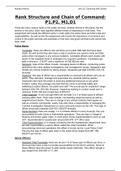Malaika Ahmed Unit 13- Command and Control
Rank Structure and Chain of Command:
P1,P2, M1,D1
There are many various ranks in the public services, whether that be in the police, the fire
service or the army. Each rank signifies different levels of importance in that force. This
assignment will include the different ranks in order within the police force and their roles and
responsibilities. As well as this the assignment will include the importance of command and
control in the public services and examples of how poor and good command and control has
been used.
Police Ranks
Constable- these are officers who will show up to public 999 calls that have been
made. As well as this they also have a duty to examine any volume crime and take
action when necessary in any serious incidents. Constable officers work closely with
teams in the neighbourhood to strategies any long-term problems. Constables get
paid a minimum £19,971 and a maximum of £38,382 per year.
Sergeant- roles of this officer include; managing teams of officers, conducting police
operations like crime related investigations and management issues. Sergeant’s also
handle any critical incidents by taking charge. Sergeants get paid £39,693- £43,134
annually.
Inspector- this type of officer has a responsibility to command all officers who are on
patrol. They also plan, manage and supervises any practical policing activity.
Inspectors also have the power to send any additional resources to any given
incident. Lastly, they manage any risks that can occur to promote safety and
wellbeing to police officers, the public and staff. The annual pay for inspectors' range
between £49,176- £53,340. However, inspectors working in London would earn a
minimum of £51,330 and a maximum of £55,512.
Chief Inspector- in one borough there are normally 2 or 3 of these types of officers
working within them. Their roles include, commanding response teams as well as
neighbourhood teams. They are in charge of any critical incidents that happen as
well as a firearm commander. Lastly, they also have a responsibility of managing the
Criminal Investigation Department or more commonly known as the CID. This type of
officer would earn between £54,432- £56,670 annually.
Superintendent- there are usually 1 or 2 of these officers in every borough, they are
accountable for both Crime or Partnership operations. They are also in charge of
firearms and senior public order. In most police forces Superintendent’s work on call
24/7. Superintendent’s usually earn around £65,478- £77,340 a year.
Chief Superintendent- is in charge of policing and the headquarters department, they
are also responsible to a senior officer called the Chief Constable. When
encountering crime and operations this officer is known as the ‘Local Police Chief’.
The pay this type of officer gets when in the police force ranges from £81,156-
£85,614 per annum.
Senior Officers
Assistant Chief Constable- there are around 1-5 of these type of officers per force, in
the force they have a duty to provide accountability for the force’s policies. Some of
these officers have the power to lead certain issues nationally. This officer will get a
pay ranged from £95,538- £111,249.





